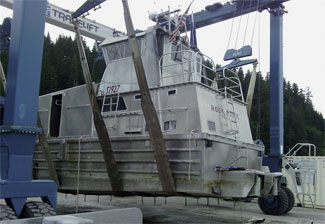An integrated tug-barge involved in a tsunami cleanup project in Alaska broke apart after hitting river ice, with heavy waves pushing both vessels aground on a beach, the U.S. Coast Guard reported.
Hook Point-Alaganik, a 77-foot ITB owned by Alaganik LLC of Cordova, Alaska, was helping to remove debris from the 2011 Japanese tsunami when the incident occurred at about 1300 on July 24. Two men were on board the vessel about 60 miles southeast of Cordova.
Coast Guard Marine Safety Unit Valdez reported that the ITB encountered heavy waves, strong currents and ice at the mouth of the Seal River. The currents caused the vessel to swing broadside into the waves, which lifted the ITB and dropped it directly onto large pieces of ice.
“The impact with the ice broke the mechanical system holding the tug and barge together and both were washed up onto the beach,” the Coast Guard reported. “Both persons on board donned survival suits, abandoned ship and made it safely to the beach with assistance from a shoreside cleanup crew.”
Robert Eckley, the owner of Alaganik LLC, said he was maneuvering the ITB to drop its bow gate on shore to pick up tsunami debris — Japanese aquaculture floats — when the conditions became too much to handle.
“The incredible melt this season made the currents just unbelievable, and with the ice in the river it was a tough landing at best,” Eckley said. “My jets got stuffed in the sand on the downhill side of the current and the surf was right there, so it was a very difficult place to go into. The Bering Glacier is just draining into this one small, narrow neck. It is not a hospitable spot.”
A National Oceanic and Atmospheric Administration buoy, about 25 miles away, reported 3- to 4-foot seas and light winds.
Eckley said the mouth of the river is navigable in spring and late fall when cold conditions limit the glacial runoff, “but during the peak of the melt it’s too dynamic to go in there with anything less than a nimble, high-powered vessel. I went in there with a large boat and the maneuverability, with the narrow drainage, is trickier than it looks on the chart.”
The Coast Guard reported that the tug and barge sustained “significant” damage, with a slight fuel sheen reported in the vicinity after the incident. Two Coast Guard pollution investigators were airlifted to the remote site and booms and absorbent pads were deployed.
Alaganik LLC contracted with Alaska Marine Response to recover fuel from the ITB and handle the salvage. At the time of the grounding, Hook Point-Alaganik was carrying 2,050 gallons of diesel fuel, 90 gallons of hydraulic oil and 30 gallons of gasoline. Responders recovered 1,740 gallons of diesel and 225 gallons of hydraulic and “miscellaneous” fluids, the Coast Guard said. The recovered material was stored in containers above the high-water line until it could be safely removed.
Temporary repairs were made to the tug and barge on the beach and both vessels were refloated on Aug. 12. They were towed separately to Cordova and were moved to shoreside storage on Aug. 15.
Eckley declined to comment on the extent of damage to the ITB or say it might be back in service.
“It’s just metal so you can put it back together,” he said. “But the insurance company is still looking at it, so how to accomplish the repair is still in limbo.”

